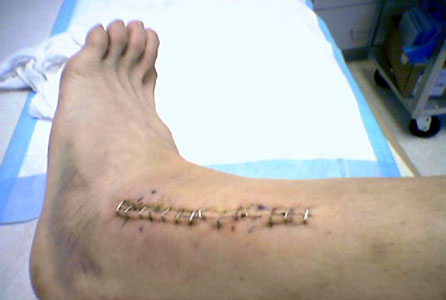
Lower Leg Surgery for Peripheral Artery Disease
Peripheral artery disease is a circulatory condition that decreases the blood flow to your limbs, including the lower legs. The legs are usually the first area where the condition is noticed. Patients with PAD experience pain in the lower legs when engaging in physical activity such as walking. The legs do not get enough blood flow to supply the legs during activity. Lower leg surgery is a treatment option for this condition after medications have failed to provide results.
The surgery is performed to ease the pain and discomfort of the patient and to stop the progression of the disease. Medications may be able to help some patients, but when there is no relief from these medications, surgery may be indicated.
There are different types of surgery that are used to treat peripheral artery disease. Angioplasty is a type of treatment that may help increase the blood flow to the lower legs. This lower leg surgery unblocks the veins that are causing a lack of blood flow to the lower extremities. A catheter is inserted into the vessel and a balloon is inflated to open up the artery. This procedure also stretches the artery allowing an increased blood flow to the lower leg. During the lower leg surgery, the doctor may also insert a stent that is designed to keep the artery open and prevent future blockages in the artery.
Another lower leg surgery for PAD is a bypass procedure. During this procedure the doctor will graft a bypass on the blocked artery allowing the blood to flow around the blocked artery. The blood vessel may be obtained from another part of the body or it may be a synthetic material.
Thrombolytic therapy is a type of lower leg surgery that injects a drug into the artery that dissolves the clot causing the blockage.
After the lower leg surgery, patients are instructed to begin an exercise program that increases the amount of time that the patient can walk comfortably without pain. Some peripheral artery patients use medication and exercise before lower leg surgery.
Physical therapy may begin soon after lower leg surgery to help recover from the procedure. Patients are encouraged to walk after the procedure as long as it is comfortable, but patients who have undergone a bypass procedure may have to remain in bed for one or two days. Mobility may be limited for a short time after the procedure and patients usually require assistance around the house during recovery.
Patients are instructed to keep their legs elevated while sitting on a chair or stool. The leg is monitored after the lower leg surgery for colour and temperature. A leg that is healing properly will not feel cold or appear pale. Increased blood flow to the leg will improve colour and temperature.
The prognosis after a lower leg surgery for peripheral artery disease depends on the amount of blockage before the procedure. Most patients will notice an increase in the distance that they are able to walk without pain or discomfort.
